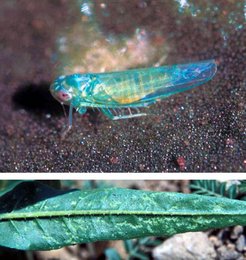Survival Strategies in Nature
Field Trials with transgenic wild tobacco (Nicotiana attenuata) reveal new and unexpected insights into plant-herbivore-interactions
Plants are both components of ecosystems as well as the basis for the nutrition of an increasing world population. However, plants permanently cope with attack from thousands of insect and microbe species, and consequently have evolved complex strategies to repel these attackers. A detailed understanding of the mechanisms of the interactions between plants and insects will help to develop sustainable agriculture. Scientists of the Max Planck Institute for Chemical Ecology in Jena, Germany, gained new insights into the fundamentals of chemical signaling within the plant after herbivore attack and in doing so have highlighted the value of genetically modifying plants for the study of complex ecological interactions in nature. They produced transgenic Nicotiana attenuata (wild tobacco) plants which were silenced in the expression of an lipoxygenase-encoding gene that mediates oxylipin signaling and therefore were unable to defensively respond to insect attack. As expected, when these unresponsive plants were planted into their native habitat, they were heavily attacked by N. attenuata’s established herbivores. However, herbivore species that were new to N. attenuata were also found to feed and reproduce successfully on the transgenic plants, revealing that lipoxygenase-dependent signaling determines host selection for opportunistic herbivores and that induced defenses influence herbivore community composition (Sciencexpress, 1 July 2004).
Scientists agree that a deep understanding of the ecological interactions that occur in nature is essential for sustainable agriculture and that the plant traits that are important for resistance to herbivore attack in nature are complex and operate on many spatial scales. They involve both direct defenses (toxins, digestibility reducers etc), that themselves protect plants as well as indirect defenses, that work with components of the plants’ community (natural enemies etc). All this functional complexity has made it difficult to figure what really matters in the rough and tumble of nature.
Genetic transformation of plants provides a valuable tool to manipulate traits that mediate these complex interactions and allows an integrative analysis of single traits. However, the evaluation of transformants is usually performed in the greenhouse with known challenges, not the vast number of unknowns that occur in nature. Moreover, the scientific value of transformed plants in ecological research has been an unfortunate casualty of the polarized debate surrounding the use of transformed plants in agriculture.
Scientists from the Max Planck Institute for Chemical Ecology report an exciting discovery about a plant trait that determines the composition of the herbivore community, which was made by genetically silencing different components of a signaling pathway that mediates induced resistance in a native plant, and planting these plants back out into their native habitat.

The researcher transformed the wild tobacco species Nicotiana attenuata, to express LOX3, HPL and AOS in an antisense orientation. All three enzymes are key regulators in the oxylipin pathway (see Figure below) and are known to play major roles in the plants’ wound recognition. However, their defensive function has only been tested in laboratory studies. When planted into native habitats, LOX3-deficient plants were more vulnerable to N. attenuata’s adapted herbivores but also attracted two novel herbivore species, which fed and reproduced successfully. These results demonstrate that jasmonate signaling determines host selection for opportunistic herbivores and that induced defences influence herbivore community composition.
Plants growing in natural habitats are under relentless pressure from herbivores. We are simply unaware of many of these attackers because they are not normally found feeding on plants. However, some species of herbivores apparently "test" plants. When the plant doesn’t respond to this testing by launching induced defenses, the plant joins the list of taxa on the herbivore’s menu.

These experiments demonstrate that by disabling individual genes in native plants and planting these plants back into their native habitats one can learn much about the challenges that plants face in the real world and how communities and ecosystems function. These experiments also illustrate the scientific value of natural habitats. Natural areas have always been scientific laboratories for naturalists and ecologists.
With the responsible use of genetically modified native plants, the scientific value of natural habitats has the potential of greatly increasing, thereby providing another impetus for their preservation.
The native tobacco plant Nicotiana attenuata is one of the model systems used by the Department of Molecular Ecology at the Max Planck Institute for Chemical Ecology in Jena to study ecological interactions. This native plant was selected because it occupies a natural ecological niche which is most similar to the niche in which agricultural plants are grown. By studying how this native plant has adapted to life in this niche, the scientists hope to find means of increasing the ecological sophistication of our agricultural crops and develop lower input and more sustainable agricultural practices.

